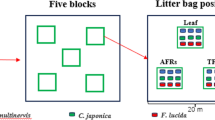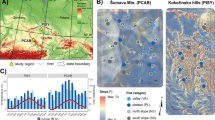Abstract
Effects of three aspen (Populus tremuloides Michx.) canopy removal treatments and root trenching on understory microenvironment and moisture were tested at Parkland and Boreal sites in Alberta, Canada. Aspen canopies moderated air temperature by reducing maximums and increasing minimums, and increased the frost-free period in the understory by reducing radiative frosts. When daily differences were found among canopy treatments, maximum absolute humidity was greater with complete canopy removal. Maximum daily relative humidity was greater in openings at night than with either full or partial canopy cover. Predictably, increasing aspen cover reduced PAR reaching the understory. Soil moisture response was highly variable, changing with site, aspen density and precipitation patterns, but there were only marginal differences due to root trenching. In the Parkland site, soil moisture conservation from aspen canopy and leaf litter effects were masked by tree uptake in most periods, but a net increase in soil water (+5.2%) was observed during drought. Soil and microclimatic conditions in thinned aspen stands suggest potentially favourable production benefits from developing and adopting agroforestry systems in these northern ecosystems.






Similar content being viewed by others
Reference
Balatinecz JJ, Kretschmann DE, Leclercq A (2001) Achievements in the utilization of poplar wood––guideposts for the future. For Chron 77:217–392
Brooker RW, Callaghan TV (1998) The balance between positive and negative plant interactions and its relationship to environmental gradients: a model. Oikos 81:196–207
Cannell MGR, Grace J (1993) Competition for light: detection, measurement and quantification. Can J For Res 23:1969–1979
Carlson DW, Groot A (1997) Microclimate of a clear-cut, forest interior and small openings in trembling aspen forest. Agr Forest Meteorol 87:313–329
Dang Q-L., Margolis HA, Coyea MR, Sy M, Collatz GJ (1997) Regulation of branch level gas exchange of boreal trees: roles of shoot water potential and vapour pressure difference. Tree Physiol 17:521–535
Grace J (1983) Plant-atmosphere relationships. Outline studies in ecology. Chapman and Hall, New York, p 72
Groot A, Carlson DW (1996) Influence of shelter on night temperatures, frost damage, and bud break of white spruce seedlings. Can J For Res 26:1531–1538
Hogg EH, Saugier B, Pontailler J-Y., Black TA, Chen W, Hurdle PA, Wu A (2000) Responses of trembling aspen and hazelnut to vapour pressure deficit in boreal deciduous forest. Tree Physiol 20:725–734
Jose S, Gillespie AR, Seifort JR, Biehle DF (2000) Defining competition vectors in a temperate alley cropping system in the midwestern USA. Agroforest Syst 48:41–59
Littell RC, Stroup WW, Freund RJ (2002) SAS® for linear models, 4th edn. SAS Institute Inc., Cary NC, 466 pp
Man R, Lieffers VJ (1997) Seasonal photosynthetic responses to light and temperature in white spruce (Picea glauca) seedlings planted under an aspen (Populus tremuloides) canopy and in the open. Tree Physiol 17:437–444
Marsden BJ, Lieffers VJ, Zwiazek JJ (1996) The effect of humidity on photosynthesis and water relations of white spruce seedlings during the early establishment phase. Can J For Res 26:1015–1021
Powell GW (2003) Competition and facilitation in aspen agroforests. Ph.D. Thesis, Department of Agricultural, Food, and Nutritional Science, University of Alberta, Edmonton Alberta, 274 pp
Ramankutty N, Foley JA (1999) Estimating historical changes in land cover: North American croplands 1850 to 1992. Global Ecol Biogeo 8:381–396
Strong WL, La Roi GH (1983) Rooting depth and successional development of selected boreal forest communities. Can J For Res 13:577–588
Strong WL, Leggat KR (1992) Ecoregions of Alberta. Alberta Forestry, Lands and Wildlife, Edmonton AB, 59 pp
Acknowledgements
Our gratitude is extended to James Cahill, Jane King, Vic Lieffers, John Hoddinott, Dale Bartos and 2 anonymous reviewers, for their feedback on earlier versions of this manuscript. Funding was provided by the Alberta Agriculture Research Institute, the Agriculture and Food Council of Alberta, the Alberta Crop Industry Development Fund, the Biodiversity Challenge Grants Program supported by the Alberta Conservation Association, the Natural Sciences and Engineering Research Council of Canada, and the Killam Trusts. Thanks to Sarah Green for her technical assistance, as well as Dr. Barry Irving and staff at the University of Alberta Kinsella Research Station and the Lakeland Agricultural Research Association.
Author information
Authors and Affiliations
Corresponding author
Rights and permissions
About this article
Cite this article
Powell, G.W., Bork, E.W. Effects of aspen canopy removal and root trenching on understory microenvironment and soil moisture. Agroforest Syst 70, 113–124 (2007). https://doi.org/10.1007/s10457-007-9051-z
Received:
Revised:
Accepted:
Published:
Issue Date:
DOI: https://doi.org/10.1007/s10457-007-9051-z




